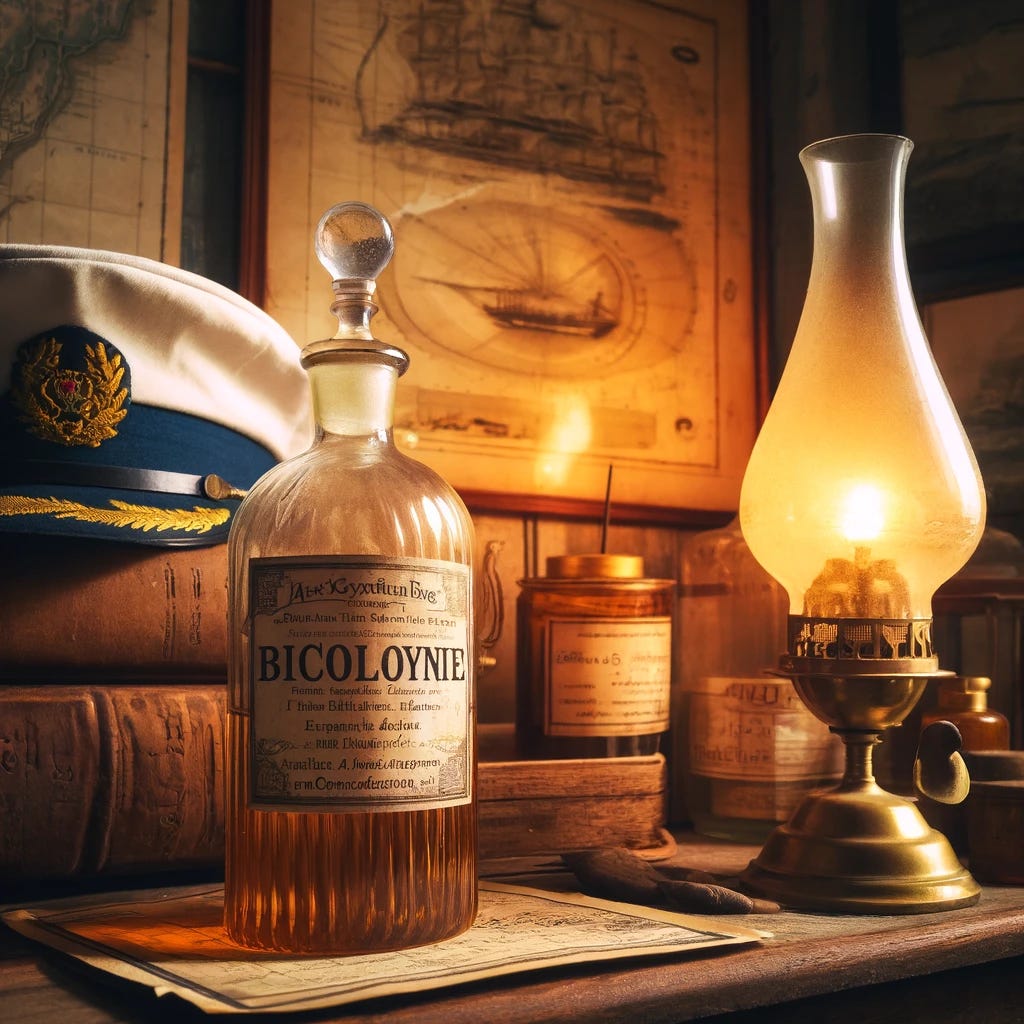Tucked into the advertising columns of The Argyleshire Herald, past announcements for queys and bulls, and somewhere near the prize-winning Ayrshire cows of Kilwhipnach, a curious remedy makes its appearance:
“The Campbelton Apothecary Hall, offering to prevent our sea-sickness with a dose of their Bicolotyne.”
It sounds promising. Even elegant. Bicolotyne — the name rolls off the tongue with pharmaceutical authority and a whiff of Victorian marketing genius. But what exactly was Bicolotyne? Who made it, what was in it, and did it actually work?
In this blog post, we’ll unravel the origins and mystery behind this obscure remedy, explore the culture of sea-sickness in the age of sail and steam, and take a lighthearted dive into the often questionable world of 19th-century medicine.
Sea-Sickness in the Age of Steamboats
The 19th century was the golden age of sea travel — and also of sea-suffering.
With the rise of paddle steamers and improved maritime transport connecting places like Campbeltown to Glasgow, Islay, and beyond, people were traveling more often — and not always comfortably. The West Highland coast, while picturesque, was notoriously choppy. Journeys around the Mull of Kintyre could be stomach-churning at best, perilous at worst.
Sea-sickness wasn’t just unpleasant — it could be debilitating, humiliating, and even dangerous if the passenger was too unwell to react to emergencies on board. Remedies were eagerly sought, and every apothecary worth their salt stocked some kind of anti-nausea elixir — each with a name more mysterious and confident than the last.
Enter: Bicolotyne.
Bicolotyne: Fact, Fiction, or Fancy Name?
There are no surviving medical records or pharmacopoeias from the 19th century that explicitly list Bicolotyne as a registered or standardized medicine. That’s our first clue. It likely wasn’t a proprietary formula known across the UK, but rather a local or regional concoction — possibly made in-house at Campbeltown’s Apothecary Hall.
This wasn't unusual. Apothecaries in Victorian towns often compounded their own medicines. They would mix herbs, tinctures, alcohols, minerals, and secret ingredients (sometimes proprietary, sometimes wildly unsafe) into tonics for everything from headaches to heartbreak.
Given the name, we can guess a few things:
“Bico-” suggests a compound — possibly “bi” for two major ingredients.
“-lotyne” has a medicinal, even chemical-sounding ending, similar to laudanum, morphine, quinine, or atropine.
So what might have been in it?
Common 19th-Century Ingredients for Sea-Sickness:
Opium or laudanum: Frequently used in low doses to calm nerves and nausea.
Alcohol: Whiskey or brandy was a staple base for many Victorian tonics.
Peppermint oil: Known for its calming effect on the stomach.
Ginger extract: A traditional anti-nausea remedy, still used today.
Belladonna (deadly nightshade): Contains atropine; sometimes used for muscle spasms and nausea, but risky.
Chloral hydrate: A sedative sometimes used to “knock out” motion sickness entirely.
Any combination of these — sweetened, bottled, and branded as “Bicolotyne” — could have made its way into a small green bottle at the Campbeltown chemist.
Miracle or Menace? The Risky World of Victorian Remedies
There was no FDA or MHRA in Victorian Scotland. No regulations, no safety testing. Medicine was part science, part superstition, and part savvy marketing.
If Bicolotyne made you feel better, it might’ve been the ginger or peppermint. If it knocked you out cold for the duration of the ferry ride, you might’ve been sipping laudanum in disguise. Either way, the pharmacist probably sold a good number of bottles to weary travelers boarding the steamers to Glasgow.
It’s also likely that Bicolotyne was branded for one specific problem — seasickness — because that was the prevailing local concern. The connection between medicine and local geography was often direct: if you lived near the sea, you needed something for nausea. If you lived in the Highlands, maybe it was gout, exposure, or whisky overindulgence.
Bicolotyne was Campbeltown’s apothecary solution to its coastal condition.
Apothecary Hall: A Forgotten Institution of Trust
Let’s not forget the source: Campbeltown Apothecary Hall. In a time before public healthcare, the apothecary was the front line of medical advice. The local chemist was part doctor, part therapist, and part miracle-worker.
These halls were institutions of trust — somewhere between a pharmacy and a general store. You’d walk in, describe your ailment in plain terms (“waves make me dizzy, man!”), and walk out with a corked bottle and strict instructions: “Two spoonfuls before boarding. Do not mix with brandy. Or do, if you're a betting man.”
Though we have no surviving address or photograph of the original Apothecary Hall, it's likely it was a familiar building on Main Street or near the quay — somewhere easy to reach before catching the boat. Its wares, from patent tonics to personal mixtures like Bicolotyne, would have been as local as the sea air.
Would It Work Today?
Modern medicine has evolved quite a bit since Bicolotyne’s heyday. Today we treat sea-sickness with things like:
Dimenhydrinate (Dramamine)
Scopolamine patches
Ginger capsules
Pressure-point wristbands
And yet, many of the old remedies still have fans. Ginger, peppermint, even motion-sickness whiskey (ahem) are alive and well in maritime communities.
So would Bicolotyne work today? Depends what's in it — and how brave you are.
A Bottle of History, Lost at Sea
There’s a charm in the fact that no exact record of Bicolotyne survives. It joins the long list of old Scottish remedies with big promises and mysterious recipes — relics of a time when science, superstition, and entrepreneurial spirit danced together in an amber bottle.
Somewhere, perhaps in a dusty drawer of a Campbeltown attic, there’s a label, a ledger, or even a bottle with “Bicolotyne” hand-lettered in fading ink. Until then, we can only imagine its taste, its kick, and the calm confidence it offered to seasick souls on a stormy Highland crossing.





